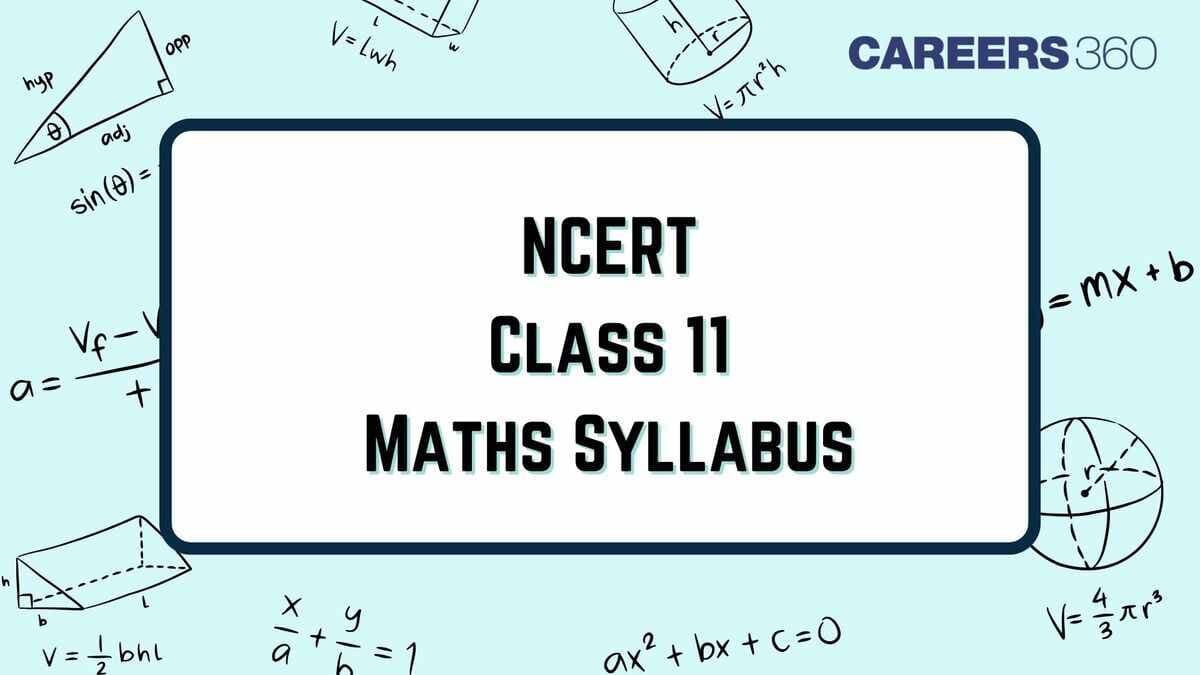Aakash Repeater Courses
ApplyTake Aakash iACST and get instant scholarship on coaching programs.
Class 11 mathematics makes a significant jump from the simple concepts of the previous classes to more abstract, complex, and advanced ones. There are many chapters in class 11 maths with advanced mathematical concepts which require deeper logical analysis and critical thinking ability to understand. The NCERT Syllabus for Class 11 introduces these concepts in a clear and well-organised manner to the students. More insights and information regarding the NCERT Class 11 Maths Syllabus PDF are given below. At first, the Class 11 maths syllabus may appear large and complex to the students, but it can be easily understood with proper guidance.

This article will provide a chapter-wise detailed analysis of the NCERT Syllabus Class 11 Maths 2025-26, to help the students in their studies. The NCERT Syllabus is created in such a way that it plays an important role in developing the problem-solving, analytical, and logical skills of the students. With the proper knowledge about the syllabus, students can be well prepared for their exams. Students can also refer to the NCERT Books according to the latest syllabus.
The class 11 maths syllabus contains 5 units with a total of 14 chapters. The table below contains every chapter along with its subtopics.
Chapter 1: Sets
Chapter 2: Relations and Functions
Chapter 3: Trigonometric Functions
Chapter 4: Complex Numbers and Quadratic Equations
Chapter 5: Linear Inequalities
Chapter 6: Permutations and Combinations
Chapter 7: Binomial Theorem
Chapter 8: Sequence and Series
Chapter 9: Straight Lines
Chapter 10: Conic Sections
Chapter 11: Introduction to Three-Dimensional Geometry
Chapter 12: Limits and Derivatives
Chapter 13: Statistics
Chapter 14: Probability
You can simply click on the link below to directly download the PDF file and access it offline whenever you like:
Download NCERT syllabus for class 11 Maths 2025-26 PDF
The Class 11 Maths exam pattern includes a total of 80 marks for the theory paper and 20 marks for the internal assessment. The division of the expected marks according to the units is given below for the reference of the students.
|
Units |
Expected Marks |
|
Unit - I |
23 |
|
Unit - II |
25 |
|
Unit - III |
12 |
|
Unit - IV |
08 |
|
Unit - V |
12 |
|
Total (Theory) |
80 |
|
Internal Assessment |
20 |
NCERT books provide conceptual clarity and also give an insight into what can be asked in exams. Class 11 Maths is very important for all the engineering entrance exams like JEE. So, it becomes very important for a student to follow good reference books after completing the NCERT book as well as the NCERT Exemplar for class 11 Maths. Here are some suggestions for some of the best reference books for Class 11 Maths:
Also check: NCERT books for Class 11 for all Subjects
The Class 11 NCERT Maths syllabus is very crucial if you are looking for a bright career in the field of engineering. NCERT books give you a proper understanding of the concepts, whereas reference books, previous years' questions, and practice sets will help you to improve your command of the subject.
Along with the NCERT Mathematics preparation, the students should also ensure that they do not lag behind while preparing for the other subject examinations. The links to the syllabi of the various other subjects are given below:
There are 5 units with a total of 14 chapters in Class 11 Maths. The main units covered in Class 11 Maths are Sets and Functions, Algebra, Coordinate Geometry, Calculus, Statistics and Probability.
The external exam totals 80 marks: Sets & Functions (23), Algebra (25), Coordinate Geometry (12), Calculus (8), and Statistics & Probability (12); plus 20 marks in the internal assessment.
Start with NCERT textbooks and NCERT solutions, revise important formulas and concepts regularly, and solve exemplar questions and previous year papers for practice.
Yes, Trigonometric Functions and Complex Numbers are included in the Class 11 NCERT syllabus in chapters 3 and 4, respectively. Trigonometric Functions are covered under the unit Sets and Functions, while Complex Numbers are covered under the unit of Algebra.
Algebra and Sets & Functions units carry the highest weightage in the class 11 maths exam, carrying 25 and 23 marks, respectively.

Take Aakash iACST and get instant scholarship on coaching programs.

This ebook serves as a valuable study guide for NEET 2025 exam.

This e-book offers NEET PYQ and serves as an indispensable NEET study material.

As per latest syllabus. Physics formulas, equations, & laws of class 11 & 12th chapters

As per latest syllabus. Chemistry formulas, equations, & laws of class 11 & 12th chapters
As per latest 2024 syllabus. Study 40% syllabus and score upto 100% marks in JEE